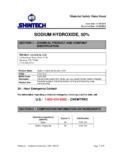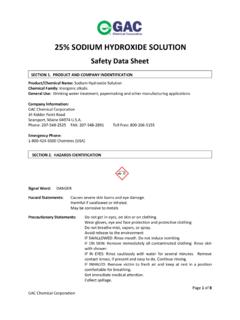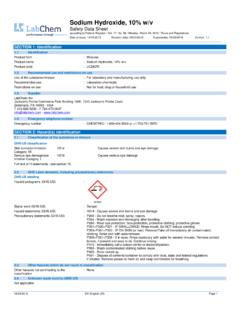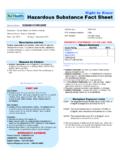Transcription of Material Safety Data Sheet Page 1 of 5. Sodium …
1 Material Safety Data Sheet Page 1 of 5. Sodium hydroxide , solid Section 1 - Chemical Product and Company Identification MSDS Name: Sodium hydroxide , solid. Synonyms: Lye, Sodium hydrate, white caustic, caustic soda, soda lye, soda ash, ascarite. Company Identification: Certified Lye PO Box 133. Spring Valley, CA 91976-0133. Website: Email: Telephone: 619-548-2378. Poison Control Center: 800-222-1222. Chemtrec: 800-424-9300. Section 2 - Composition, Information on Ingredients CAS#, Chemical Name, Percent, EINECS/ELINCS: 1310-73-2, Sodium hydroxide , 99-100, 215-185-5. 497-19-8, Sodium carbonate, < , 207-838-8. Food Chemical Codex (FCC): These chemicals meet the FDA requirements for food use. Section 3 - Hazards Identification Emergency Overview Appearance: White solid. Danger! Causes eye and skin burns. Causes digestive and respiratory tract burns. Hygroscopic (absorbs moisture from the air). Target Organs: Eyes, skin, mucous membranes. Potential Health Effects Eye: Causes eye burns.
2 May cause blindness. May cause chemical conjunctivitis and corneal damage. Skin: Causes skin burns. May cause deep, penetrating ulcers of the skin. Ingestion: May cause severe and permanent damage to the digestive tract. Causes gastrointestinal tract burns. May cause perforation of the digestive tract. Causes severe pain, nausea, vomiting, diarrhea, and shock. Inhalation: Irritation may lead to chemical pneumonitis and pulmonary edema. Causes severe irritation of upper respiratory tract with coughing, burns, breathing difficulty, and possible coma. Causes chemical burns to the respiratory tract. Chronic: Prolonged or repeated skin contact may cause dermatitis. Effects may be delayed. Section 4 - First Aid Measures Eyes: In case of contact, immediately flush eyes with plenty of water for a t least 15. minutes. Get medical aid immediately. Skin: In case of contact, immediately flush skin with plenty of water for at least 15. minutes. Immediately remove contaminated clothing and shoes.
3 Get medical aid immediately. Wash clothing before reuse. Ingestion: If swallowed, do NOT induce vomiting. Get medical aid immediately. If victim is fully conscious, give a cupful of water. Never give anything by mouth to an unconscious person. Inhalation: If inhaled, remove to fresh air. If not breathing, give artificial respiration. If breathing is difficult, give oxygen. Get medical aid. Notes to Physician: Treat symptomatically and supportively. MSDS for Lye ( Sodium hydroxide ) printed from Material Safety Data Sheet Page 2 of 5. Sodium hydroxide , solid Section 5 - Fire Fighting Measures General Information: As in any fire, wear a self-contained breathing apparatus in pressure-demand, MSHA/NIOSH (approved or equivalent), and full protective gear. Use water spray to keep fire-exposed containers cool. Use water with caution and in flooding amounts. Contact with moisture or water may generate sufficient heat to ignite nearby combustible materials. Contact with metals may evolve flammable hydrogen gas.
4 Extinguishing Media: Substance is noncombustible; use agent most appropriate to extinguish surrounding fire. Do not get water inside containers. Flammability: Nonflammable. Flash Point: Not applicable. Autoignition Temperature: Not applicable. Flammable Limits: Not available. NFPA Rating: Health: 3; Flammability: 0; Instability: 1. Section 6 - Accidental Release Measures General Information: Use proper personal protective equipment as indicated in Section 8. Spills/Leaks: Vacuum or sweep up Material and place into a suitable disposal container. Avoid runoff into storm sewers and ditches that lead to waterways. Clean up spills immediately, observing precautions in the Protective Equipment section. Avoid generating dusty conditions. Provide ventilation. Do not get water on spilled substances or inside containers. Section 7 - Handling and Storage Handling: Wash thoroughly after handling. Do not allow water to get into the container because of violent reaction. Minimize dust generation and accumulation.
5 Do not get in eyes, on skin, or on clothing. Keep container tightly closed. Avoid ingestion and inhalation. Discard contaminated shoes. Use only with adequate ventilation. Storage: Store in a tightly closed container. Store in a cool, dry, well-ventilated area away from incompatible substances. Keep away from metals. Keep away from acids. Store protected from moisture. Containers must be tightly closed to prevent the conversion of NaOH to Sodium carbonate by the CO2 in air. Section 8 - Exposure Controls, Personal Protection Engineering Controls: Facilities storing or utilizing this Material should be equipped with an eyewash facility and a Safety shower. Use adequate general or local exhaust ventilation to keep airborne concentrations below the permissible exposure limits. Exposure Limits Chemical Name, ACGIH (TLV), NIOSH (REL), OSHA (PEL): Sodium hydroxide , 2 mg/m3 Ceiling, 10 mg/m3 Ceiling (15 minutes), 2 mg/m3 TWA. Sodium carbonate, none listed, none listed, none listed. NIOSH IDLH Concentration: 10 mg/m3.
6 OSHA Vacated PEL: None of these chemicals have an OSHA Vacated PEL. Personal Protective Equipment Eyes: Wear chemical splash goggles and face shield. Skin: Wear gloves, apron, and/or clothing made of butyl rubber, nitrile rubber, and/or polyethylene. Clothing: Wear appropriate protective clothing to prevent skin exposure. Respirator: A respiratory protection program that meets OSHA's 29 CFR and ANSI requirements or European Standard EN 149 must be followed whenever workplace conditions warrant respirator use. MSDS for Lye ( Sodium hydroxide ) printed from Material Safety Data Sheet Page 3 of 5. Sodium hydroxide , solid Section 9 - Physical and Chemical Properties Physical State: Solid. Appearance: White pellets. Odor: Odorless. pH: 14 (5% aq soln). Vapor Pressure: 1 mm Hg @ 739 deg C. Vapor Density: Not available. Evaporation Rate: Not available. Viscosity: Not available. Boiling Point: 1390 deg C @ 760 mm Hg. Freezing/Melting Point: 318 deg C. Decomposition Temperature: Not available.
7 Solubility: Soluble. Specific Gravity/Density: g/cm3. Molecular Formula: NaOH. Molecular Weight: Section 10 - Stability and Reactivity Chemical Stability: Stable at room temperature in closed containers under normal storage and handling conditions. Conditions to Avoid: Moisture, contact with water, exposure to moist air or water, prolonged exposure to air. Incompatibilities with Other Materials: Water, metals, acids, aluminum, zinc, tin, nitromethane, leather, flammable liquids, organic halogens, wool. Hazardous Decomposition Products: Toxic fumes of Sodium oxide. Hazardous Polymerization: Will not occur. Section 11 - Toxicological Information NIOSH RTECS#. CAS# 1310-73-2 ( Sodium hydroxide ): WB4900000. CAS# 497-19-8 ( Sodium carbonate): VZ4050000. LD50/LC50. CAS# 1310-73-2: CAS# 497-19-8: Draize test, rabbit, eye: 400 ug Mild; Draize test, rabbit, eye: 100 mg/24H Moder;. Draize test, rabbit, eye: 1% Severe; Draize test, rabbit, eye: 50 mg Severe;. Draize test, rabbit, eye: 50 ug/24H Severe; Draize test, rabbit, skin: 500 mg/24H Mild.
8 Draize test, rabbit, eye: 1 mg/24H Severe; Inhalation, mouse: LC50 = 1200 mg/m3/2H;. Draize test, rabbit, skin: 500 mg/24H Severe. Inhalation, rat: LC50 = 2300 mg/m3/2H;. Oral, mouse: LD50 = 6600 mg/kg;. Oral, mouse: LD50 = 6600 mg/kg;. Oral, rat: LD50 = 4090 mg/kg. Carcinogenicity CAS# 1310-73-2: Not listed by ACGIH, IARC, NTP, or CA Prop 65. CAS# 497-19-8: Not listed by ACGIH, IARC, NTP, or CA Prop 65. Epidemiology: No information found. Teratogenicity: No information found. Reproductive Effects: No information found. Mutagenicity: See actual entry in RTECS for complete information. Neurotoxicity: No information found. Other Studies: No information found. Section 12 - Ecological Information No information available. MSDS for Lye ( Sodium hydroxide ) printed from Material Safety Data Sheet Page 4 of 5. Sodium hydroxide , solid Section 13 - Disposal Considerations Chemical waste generators must determine whether a discarded chemical is classified as a hazardous waste. US EPA guidelines for the classification determination are listed in 40 CFR Additionally, waste generators must consult state and local hazardous waste regulations to ensure complete and accurate classification.
9 RCRA F List: None of these chemicals are listed in 40 CFR RCRA K List: None of these chemicals are listed in 40 CFR RCRA P List: None of these chemicals are listed in 40 CFR (e). RCRA U List: None of these chemicals are listed in 40 CFR (f). Section 14 - Transport Information US DOT, Canada TDG. Shipping Name: Sodium hydroxide , solid; Sodium hydroxide , solid. Hazard Class: 8, 8. UN Number: UN1823, UN1823. Packing Group: II, II. Section 15 - Regulatory Information US Federal Regulations TSCA Section 8(b): CAS# 1310-73-2 is listed on the TSCA inventory. CAS# 497-19-8 is listed on the TSCA inventory. TSCA Section 12(b): None of these chemicals are listed under TSCA Section 12(b). TSCA Significant New Use Rule: None of these chemicals have a TSCA SNUR. Chemical Test Rules: None of these chemicals have a Chemical Test Rule. Health & Safety Reporting List: None of these chemicals are on the Health & Safety Reporting List. SARA Title III/EPCRA: None of these chemicals have a TPQ under EPCRA Section 302 (EHS).
10 None of these chemicals are reportable under EPCRA Section 304. None of these chemicals are reportable under EPCRA Section 313. SARA Codes: CAS# 1310-73-2: Immediate, reactive. CAS# 497-19-8: Immediate. CERCLA Hazardous Substances and Corresponding RQ: CAS# 1310-73-2: 1000 lb final RQ; 454 kg final RQ. CAS# 497-19-8: This chemical is not listed and has no RQ. Clean Air Act: None of these chemicals are listed under CAA Section 112(r). None of these chemicals are listed as hazardous air pollutants. None of these chemicals are listed as Class 1 or Class 2 Ozone Depletors. Clean Water Act: CAS# 1310-73-2 is listed as a Hazardous Substance under the CWA Section 311. None of these chemicals are listed as Priority Pollutants under the CWA Section 303. None of these chemicals are listed as Toxic Pollutants under the CWA Section 307. OSHA: None of these chemicals are considered highly hazardous by OSHA. SARA Title III/EPCRA States' Right-To-Know Lists: CAS# 1310-73-2 is listed by California, Massachusetts, Minnesota, New Jersey, and Pennsylvania.




